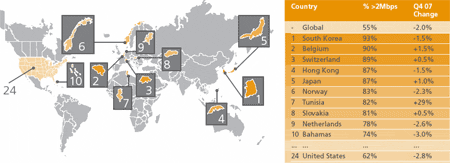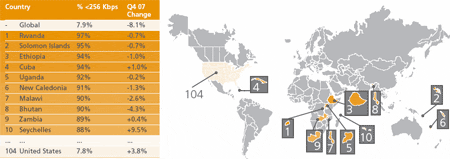Akamai: Internet Report
The largest CDN provider Akamai first published a report on the status of the Internet . This interesting document covers various topics, including security, network infrastructure of the Internet, connection speed, geographical distribution of traffic, network penetration in different countries. Lists all the largest virus outbreaks, network attacks and infrastructure outages for the I quarter. 2008
Here are some facts:
 China ranks first in the world in terms of malicious traffic, which includes including DDoS-attacks. Among the leaders are Taiwan and Venezuela, and Russia is absent even in the top ten.
China ranks first in the world in terms of malicious traffic, which includes including DDoS-attacks. Among the leaders are Taiwan and Venezuela, and Russia is absent even in the top ten.
About 30% of all attacks target 135 ports, which is designed for remote procedure calls in Windows (see the table on the right).
In March 2008, more than 10,000 web pages on hundreds of sites were infected by hackers in order to lure passwords for popular online games.
In the first quarter of 2008, the Internet grew by 329 million unique IP addresses. Now for every 20 people on Earth there is one IP address.
In one quarter, the number of unique IPs increased by 5.3% to 329 million. Among the largest countries, China is the leader in Internet growth rates (+ 7.6% of new addresses; only 32.4 million), but in the total number of devices connected to the Network the first place is still securely held by the United States: 96.8 million.
')
If we divide the number of IP addresses by population, then no one can compare with the Scandinavian countries: Sweden (0.4 IP addresses per capita), Norway, Iceland (0.37) and Finland (0.35). The sixth place is occupied by the Cayman Islands (0.34). America is only in eighth place (0.32), and the world average is 0.05.
The most high-speed Internet, as before, in South Korea and Japan. There, 64% and 48% of users, respectively, are connected to the Internet at a speed of more than 5 Mbit / s. Interestingly, Nepal is the ninth largest in the world for this indicator.

By the number of “high-speed” IP addresses per capita, the picture of the leaders is about the same.
But if you slightly reduce the speed limit to 2 Mbit / s, then the picture becomes a little more objective: two European countries, Belgium and Switzerland, fall into the top three in terms of broadband Internet share among users. In the top ten, we also see Tunisia, Slovakia and the Bahamas, and the United States descends to a distant 24th place.

In terms of the number of IP addresses at a speed of more than 2 Mbit / s per capita, the dominance of Europe is simply overwhelming: all ten first places in the world belong to European countries.
Only sympathy is caused by those countries in which users are forced to use dial-up and very slow Internet at speeds of less than 256 Kbps. The share of such connections on the Internet is scanty: only 7.9%. But in some countries, most of them. These sufferers are: Rwanda, Ethiopia, Cuba, etc.

Here are some facts:
 China ranks first in the world in terms of malicious traffic, which includes including DDoS-attacks. Among the leaders are Taiwan and Venezuela, and Russia is absent even in the top ten.
China ranks first in the world in terms of malicious traffic, which includes including DDoS-attacks. Among the leaders are Taiwan and Venezuela, and Russia is absent even in the top ten.About 30% of all attacks target 135 ports, which is designed for remote procedure calls in Windows (see the table on the right).
In March 2008, more than 10,000 web pages on hundreds of sites were infected by hackers in order to lure passwords for popular online games.
In the first quarter of 2008, the Internet grew by 329 million unique IP addresses. Now for every 20 people on Earth there is one IP address.
In one quarter, the number of unique IPs increased by 5.3% to 329 million. Among the largest countries, China is the leader in Internet growth rates (+ 7.6% of new addresses; only 32.4 million), but in the total number of devices connected to the Network the first place is still securely held by the United States: 96.8 million.
')
If we divide the number of IP addresses by population, then no one can compare with the Scandinavian countries: Sweden (0.4 IP addresses per capita), Norway, Iceland (0.37) and Finland (0.35). The sixth place is occupied by the Cayman Islands (0.34). America is only in eighth place (0.32), and the world average is 0.05.
The most high-speed Internet, as before, in South Korea and Japan. There, 64% and 48% of users, respectively, are connected to the Internet at a speed of more than 5 Mbit / s. Interestingly, Nepal is the ninth largest in the world for this indicator.

By the number of “high-speed” IP addresses per capita, the picture of the leaders is about the same.
But if you slightly reduce the speed limit to 2 Mbit / s, then the picture becomes a little more objective: two European countries, Belgium and Switzerland, fall into the top three in terms of broadband Internet share among users. In the top ten, we also see Tunisia, Slovakia and the Bahamas, and the United States descends to a distant 24th place.

In terms of the number of IP addresses at a speed of more than 2 Mbit / s per capita, the dominance of Europe is simply overwhelming: all ten first places in the world belong to European countries.
Only sympathy is caused by those countries in which users are forced to use dial-up and very slow Internet at speeds of less than 256 Kbps. The share of such connections on the Internet is scanty: only 7.9%. But in some countries, most of them. These sufferers are: Rwanda, Ethiopia, Cuba, etc.

Source: https://habr.com/ru/post/26483/
All Articles